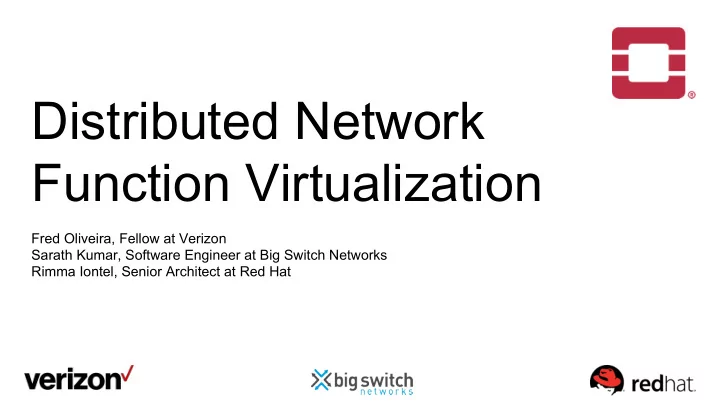

Distributed Network Function Virtualization Fred Oliveira, Fellow at Verizon Sarath Kumar, Software Engineer at Big Switch Networks Rimma Iontel, Senior Architect at Red Hat
Outline ● What is Distributed NFV? ● Why do we need Distributed NFV? ○ Verizon Use Case ● How do we implement Distributed NFV? ○ Architecture ○ Pitfalls ● Verizon + BigSwitch + Red Hat joint solution ○ Lab setup ○ Findings ● Wrap Up ● Q & A
Distributed NFV Architecture
Component Placement ● Distributed deployment of Network Functions at multiple sites with some level of remote control over those deployment models, traffic management for OpenStack and VNFs ○ Core Data Center ■ Deployment Tools ■ Network Controllers ■ Cloud Controllers ■ Orchestration ■ Monitoring, Troubleshooting and Analytics ■ Centralized Applications ○ Remote Sites ■ Compute Nodes running Edge Applications
Areas of Application ● Thick CPE (Customer Premise Equipment) Enterprise Residential ● ● ● ● ● ● ● ● ● ● ● Remote POP ○ Web Cache ○ Video Streamers ● Mobile Edge Computing
Verizon Use Case - Distributed Network Services ● Support for new NFV services requires large number of small deployments ○ Low latency for highly interactive applications (VR, AR) ○ High bandwidth video and graphics distribution ○ Edge-Datacenter support with 4-16 servers at each hundreds of locations ○ Potentially scale to a single (micro) server (CPE) at 10s of thousands of retail locations ● Improve customer experience by providing on-demand software services ● Reduce cost of service delivery ● Multiple classes of Reliability and Availability
Verizon Scenario
Evolving Economics of Networking and Computing ● Historical Processing/Storage unit costs decreasing faster than Routing/Transport ● These trends drive placing cache (CDN) closer to end users ● Continuation of these trends will make Distributed NFV more economically compelling for other network services
Goal: Customer Access to Distributed NFV Infrastructure ● Dynamic network services provided efficiently to customers ● Leverage most appropriate infrastructure to deliver the service ○ Efficient access to scalable services ○ Multiple reliability/availability classes of service ● Support for dynamic service graphs to enable distributed services ● Scalable highly-available service management
Lab Implementation Architecture
Challenges ● Deployment of Remote Compute Nodes across WAN ○ Extending L2 for provisioning ○ Network latency ● OpenStack Control Plane Communication ○ Network latency effect on the Message Bus and Database Access ○ Orchestration ○ Application deployment ○ Failure detection ● Service Resiliency ○ Headless operation ○ Service recovery ● Network Configuration, Maintenance and Troubleshooting
Lab Setup Core Data Center ● Big Cloud Fabric Controller Cluster ● Spine switches ● TOR Leaf switches ● RHOSP Director (Undercloud) ● OpenStack Controllers (Overcloud) ● Compute nodes running Switch Light VX (virtual switch) Remote Site-1 ● TOR Leaf switches ● Compute nodes running Switch Light VX (virtual switch) Latency Generator
Lab Setup: Physical Topology Core DC 10G Inband ports to the Leaf for virtual switch control path Management Switch for Out-of-band Management Network BCF Controller Cluster L2 link between Core DC & Remote Site-1 for BCF to physical switch control path Virtual Wire to send all traffic between Core DC & Remote Site-1, for Leaf to Spine data path L A T Spine Remote Site-1 E N C Y A B B B A Leaf Leaf RHOSP Director Compute Nodes Openstack Controller running SWL-VX Compute Nodes running SWL-VX
Test Objective Validate fabric resiliency with WAN latency [0-40ms] Control path latency ● Big Cloud Fabric out-of-band management network for physical switches ● Big Cloud Fabric in-band management network for virtual switches ● OpenStack control plane communications
Tests Performed Ping from a VM in the Core DC to a VM on the Remote Site-1 Success Criteria: No ping packets lost ● Controller failures ○ Failover ○ Headless mode ● Spine and leaf switch disconnects and reconnects ● Spine and leaf switch interface up/down ○ Spine to leaf connectivity ○ Leaf to compute connectivity ● Spine and leaf switch reboots
Wrap Up ● Telecom provider concerns ○ Distributed NFV architecture is essential for a variety of carrier use cases and needs to be supported across the layers of the stack, from networking to message bus to applications ○ Latency and network availability might potentially affect both initial deployment and day two operation ● Infrastructure providers’ answers ○ Red Hat OpenStack Platform components are able to handle delays produced by deployment across the WAN ○ Big Switch Networks proved that the Big Cloud Fabric was resilient even across the WAN
Q & A
Recommend
More recommend